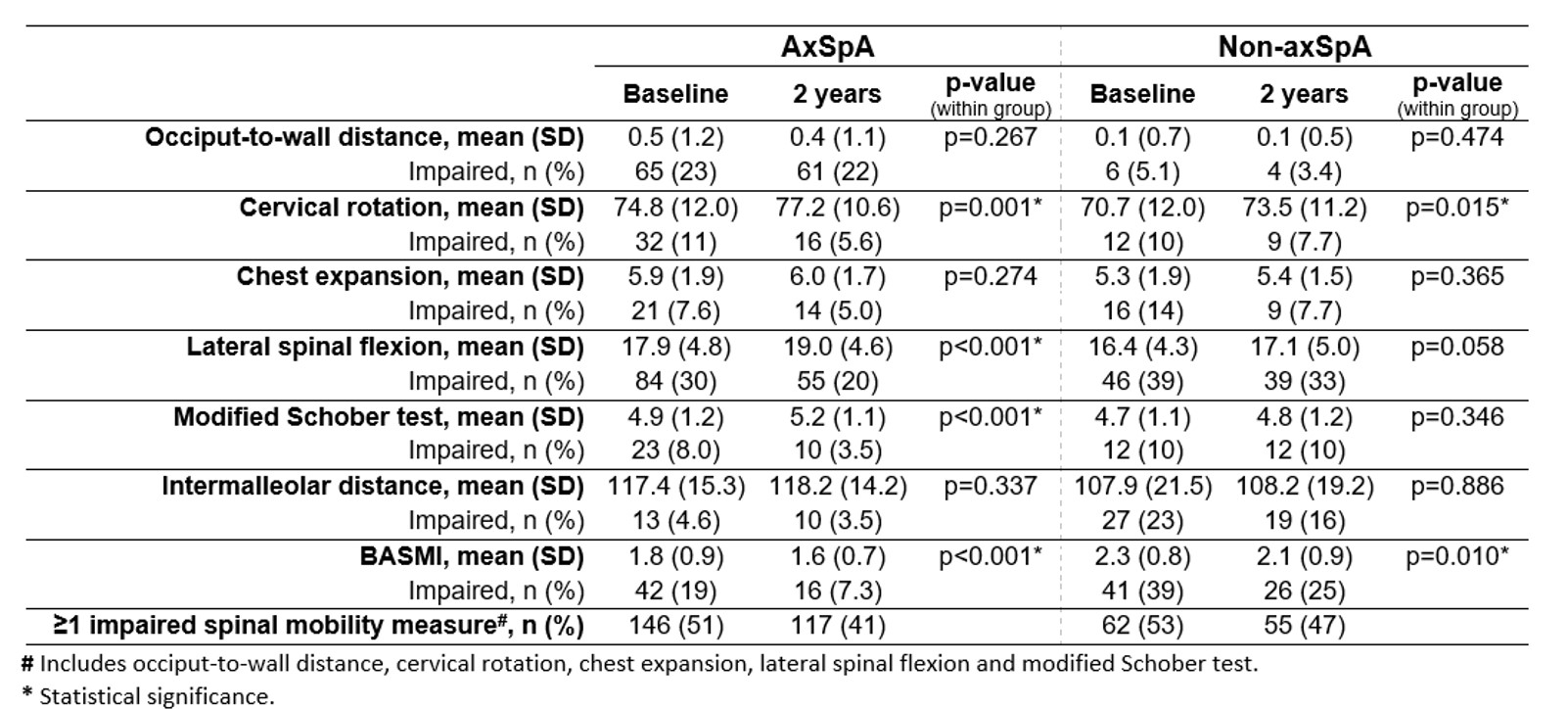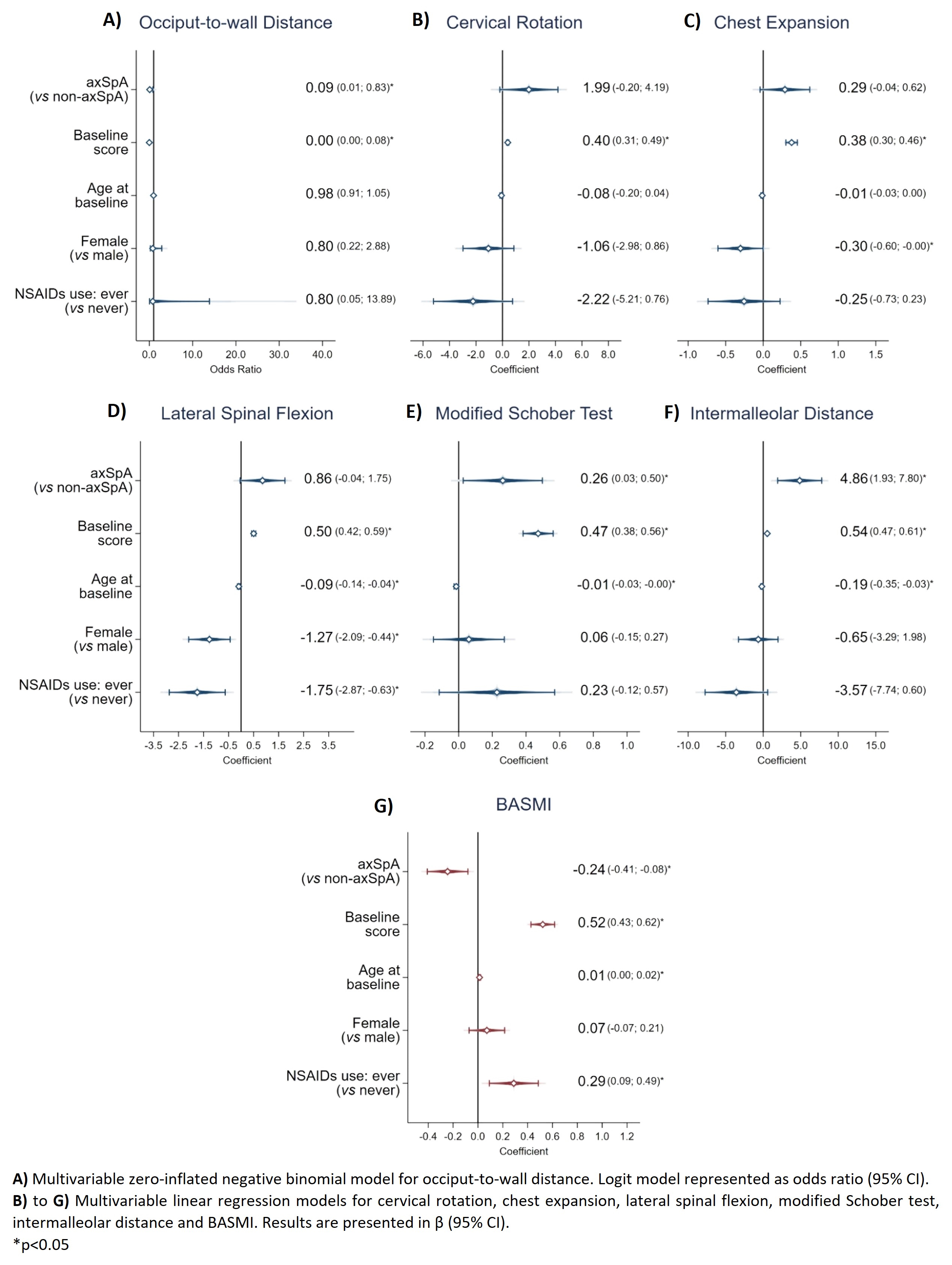Session Information
Date: Saturday, November 16, 2024
Title: SpA Including PsA – Diagnosis, Manifestations, & Outcomes Poster I
Session Type: Poster Session A
Session Time: 10:30AM-12:30PM
Background/Purpose: Axial spondyloarthritis (axSpA) frequently leads to reduced spinal and hip mobility, though evidence pertains mostly to patients with longstanding disease and radiographic damage. More recently, impaired mobility has also been reported in early axSpA. However, little is known about how spinal and hip mobility change in the first years of the disease, especially in comparison to patients with non-axSpA chronic back pain (CBP). We aimed to compare spinal and hip mobility at baseline and after 2 years (2y) in early axSpA and non-axSpA CBP patients.
Methods: Baseline and 2y data of the SPondyloArthritis Caught Early (SPACE) cohort (CBP ≥3 months and ≤2y, starting < 45 years) were analyzed. Patients had a diagnosis of axSpA or non-axSpA given by the treating rheumatologist at 2y, with a high level of confidence.1 The following mobility measures were assessed: occiput-to-wall distance (OWD), cervical rotation, chest expansion, lateral spinal flexion (LSF), modified Schober test (mSchober) and intermalleolar distance (IMD). BASMI was calculated. The proportion of patients with an impaired measure (< 2.5th percentile curves derived from healthy individuals;2 >97.5th for BASMI; >0cm for OWD) was also reported. For the assessment of each outcome, only patients with data available at both baseline and 2y were included. Paired t-test (or Wilcoxon signed rank test, as appropriate) was used to compare baseline and 2y results within groups. Linear or zero-inflated negative binomial regression was conducted to compare 2y outcomes between groups, adjusting for the baseline value (comparable to modelling a 2y change in the outcome), age, sex and NSAIDs use.
Results: Data was available at both timepoints on ≥1 of the assessed outcomes in 286 axSpA and 117 non-axSpA patients. AxSpA (vs non-axSpA) patients were more frequently male (52% vs 25%) and had more SpA features (mean [SD]: 5 [2] vs 3 [1]). Age (mean [SD]: 30 [8] vs 31 [8] years) and symptom duration (mean [SD]: 13 [7] vs 14 [7] months) were similar between groups.
At baseline, 51% axSpA and 53% non-axSpA patients had ≥1 impaired spinal mobility measure (Table 1). Overall, poorer mobility was observed in non-axSpA (vs axSpA) patients, except for OWD. After 2y, cervical rotation and BASMI significantly improved in both groups (mean [SD] improvement axSpA vs non-axSpA: cervical rotation 2.4 [11.9] vs 2.8 [12.1]; BASMI 0.2 [0.8] vs 0.2 [0.7]), and LSF and mSchober only in axSpA (LSF 1.1 [4.5]; mSchober 0.3 [1.2]).
In adjusted multivariable analysis (Figure 1), at 2y, axSpA (vs non-axSpA) was associated with larger improvements in mSchober (β [95% CI]: 0.26 [0.03; 0.50]), IMD (4.86 [1.93; 7.80]) and BASMI (-0.24 [-0.41; -0.08]), and with higher odds of OWD impairment (OR [95% CI]: 0.09 [0.01; 0.83]). No differences between groups were observed for cervical rotation, chest expansion or LSF.
Conclusion: Impaired spinal and hip mobility are common in early axSpA and, most notably, non-axSpA patients. After 2y, mobility measures remain relatively unchanged. Nevertheless, axSpA is associated with larger improvements in mSchober, IMD and BASMI, and with higher odds of OWD impairment.
References: 1. Marques ML, ARD 2024;83:589-98; 2. Ramiro S, ARD 2015;74:1218-24
To cite this abstract in AMA style:
Bento da Silva A, Ramiro S, van Lunteren M, Marques M, Van De Sande M, Fongen C, Exarchou S, Ramonda R, van der Heijde D, van Gaalen F. A Two-year Comparison of Spinal and Hip Mobility Between Axial Spondyloarthritis and Chronic Back Pain Patients in the SPondyloArthritis Caught Early (SPACE) Cohort [abstract]. Arthritis Rheumatol. 2024; 76 (suppl 9). https://acrabstracts.org/abstract/a-two-year-comparison-of-spinal-and-hip-mobility-between-axial-spondyloarthritis-and-chronic-back-pain-patients-in-the-spondyloarthritis-caught-early-space-cohort/. Accessed .« Back to ACR Convergence 2024
ACR Meeting Abstracts - https://acrabstracts.org/abstract/a-two-year-comparison-of-spinal-and-hip-mobility-between-axial-spondyloarthritis-and-chronic-back-pain-patients-in-the-spondyloarthritis-caught-early-space-cohort/


